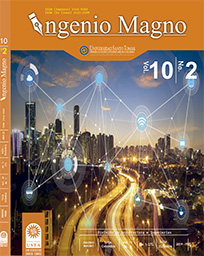Diseño de prototipo electrónico para terapia física de muñeca afectada por síndrome del túnel del carpo
Contenido principal del artículo
Resumen
El trabajo tuvo lugar en cuatro grandes etapas: la primera, de revisión documental sobre aparatos de esas características disponibles en el mercado actual, y de prototipos y simulaciones realizadas por diferentes investigadores; otra de escritura de la propuesta en concordancia con lo anterior, la siguiente, de construcción, observación y diseño en computador del dispositivo, y la última correspondiente al análisis de resultados y conclusiones.
Con financiación propia, primero se construyó el aparato para comprender mejor la lógica de su diseño, con atención a las necesidades terapéuticas de flexión y extensión de la muñeca y así, llegar a la proyección por computador. Se realizó el control y programación de un servomotor MG966, mediante el programa Arduino; el dispositivo es un Arduino 2560 diseñado mediante Autodesk Inventor. El aparato realiza movimientos de flexión y extensión a 65°, cada uno, que permiten rehabilitar la muñeca afectada por STC para liberar el nervio mediano.
Descargas
Detalles del artículo
DECLARACIÓN DE ORIGINALIDAD DE ARTÍCULO PRESENTADO
Por medio del presente documento, certifico(amos) que el artículo que se presenta para posible publicación en la revista institucional INGENIO MAGNO del Centro de Investigaciones de Ingeniería Alberto Magno CIIAM de la Universidad Santo Tomás, seccional Tunja, es de mi (nuestra) entera autoría, siendo su contenido producto de mi (nuestra) directa contribución intelectual y aporte al conocimiento.
Todos los datos y referencias a publicaciones hechas están debidamente identificados con su respectiva nota bibliográfica y en las citas que se destacan como tal. De requerir alguna clase de ajuste o corrección, comunicaré(emos) de tal procedimiento con antelación a los responsables de la revista.
Por lo anteriormente expresado, declaro(amos) que el material presentado en su totalidad se encuentra conforme a la legislación aplicable en materia de propiedad intelectual e industrial de ser el caso, y por lo tanto, me(nos) hago (hacemos) absolutamente responsable(s) de cualquier reclamación relacionada a esta.
En caso que el artículo presentado sea publicado, manifiesto(amos) que cedo(emos) plenamente a la Universidad Santo Tomás, seccional Tunja, los derechos de reproducción del mismo.
Citas
Arduino. Arduino Mega 2560, (2019) Recuperado de: https://store.arduino.cc/usa/mega-2560-r3
Asociación de fisioterapeutas españoles – AFE. (s.f.). Síndrome del túnel del carpo. Recuperado de: http://www.aefi.net/Fisioterapiaysalud/Sindrometuneldecarpo.aspx
Ávila, P. (2018). Desarrollo de un prototipo automático para rehabilitación de muñeca con dos grados de libertad. (Tesis de pregrado) Universidad Politécnica Salesiana, Cuenca, Ecuador.
Destarac, M. (S.f.). Exoesqueletos comerciales para la rehabilitación del brazo. Recuperado de: https://marieandredestarac.wordpress.com/2016/09/07/exoesqueletos-comerciales-para-la-rehabilitacion-del-brazo/
D. Williams, H.I. Krebs, N. Hogan. (2001). A robot for wrist rehabilitation. Estudio de la universidad de Cambridge, Departamento de Ingeniería Mecánica del Instituto Técnico de Massachusetts – MIT, Cambridge.
García G., Antony. (2016) ¿Qué es y cómo funciona un servomotor? Recuperado de: http://panamahitek.com/que-es-y-como-funciona-un-servomotor/
Gómez, J., Moreno J., Gil, G., Becerra, J y Orozco, C. (2016). Rehabilitación de la mano con órtesis robóticas. Revista Colombiana de Medicina Física y Rehabilitación: revistacmfr.org, vol. 26, pp. 174 – 179, Manizales, Colombia.
Hocoma. Armeo Spring Therapy. Recuperado de: www.hocoma.com
Infouruguay. Historia del acrílico. Recuperado de: https://www.infouruguay.com.uy/HISTO RIA-ACRILICO.htm (Sin fecha)
Internet medical publishing, (2015). Guía de práctica clínica del síndrome del túnel carpiano. Recuperado de: https://bit.ly/38FTZQz
Khokhar, Z., Xiao, Z., Sheridan C., y Menon, C. (S.f.). A Novel Wrist Rehabilitation/Assistive Device. (Tesis de pregrado). Universidad Simon Fraser, Burnby BC, Canadá.
Medicalexpo. Manovo Power. Recuperado de: http://www.medicalexpo.es/prod/hoco ma/product-68750-773908.html
Medina G., C.E., Benet R., M. y Marco M., F. (2016). El complejo articular de la muñeca: aspectos anatofisiológicos y biomecánicos, características, clasificación y tratamiento de la fractura distal del radio. MediSur, 14(4), pp. 430 – 446.
Motorika. What makes the ReoGo unique? Recuperado de:www.motorika.com
Naylamp Mechatronics. Servo MG996R 11Kg. Recuperado de: https://naylampmechatronics.com/serv omotores/343-servo-mg996r-11kg.html (Sin fecha)
Rinderknetch, M. (2012). Device for a novel hand and wrist Rehabilitation Strategy for Stroke Patiens Based on Illusory Movements Induced by Tendon
Vibration. Investigación del laboratorio de sistemas robóticos, de la Escuela Politécnica Federal, presentado en 16ª Conferencia Electrónica del Mediterráneo de Escuela Politécnica Federal, Lausanne, Francia. Recuperado de: https://ieeexplore.ieee.org/document/6 196579
Rueda, M.C. (2019) Síndrome del Túnel Carpiano. (Informe Técnico). Ministerio de Salud y Protección Social, Bogotá, Colombia, Recuperado de: https://www.minsalud.gov.co/Documen tos%20y%20Publicaciones/SINDROME%2 0TUNEL%20DE%20CARPIO.pdf .
Secretaría Distrital de Integración Social: Subdirección de Gestión y Desarrollo de Talento Humano, Subsistema de Seguridad y Salud en el Trabajo. (2015). Desórdenes músculo esqueléticos. (Informe Técnico). Bogotá, Colombia.
Tecnología. Servomotores, (2019) Recuperado de: https://www.areatecnologia.com/elect ricidad/servomotor.html
Velásquez, C. (2010). Guía de práctica clínica, Síndrome del Túnel del Carpo (Documento de apoyo). Medellín, Colombia. Recuperado de: file:///C:/Users/Lily/Downloads/DA0400- 142-V1.pdf

